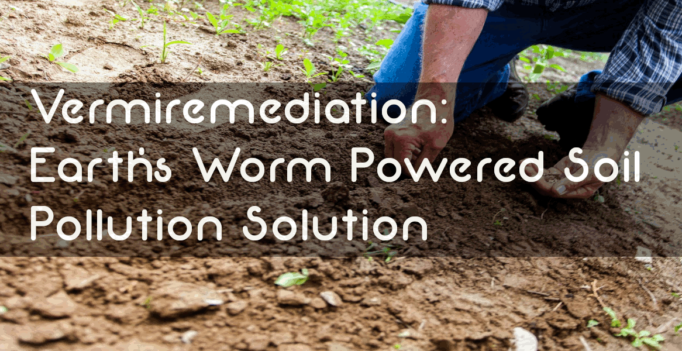Were you born with a green thumb, always curious about things that grow and naturally drawn to the soil? Perhaps your love of nature grew over time, revealing your natural rhythms and connections along the way.
Either way, given a chance, it’s easy to form a deep appreciation for this earth we call home. And maybe to feel a bit of ownership and responsibility when things go awry.
That’s why at The Squirm Firm, we’re mobilizing- each in our own sized way- to be aware of what is possible, and to be wise in our actions and stewardship of Eisenia fetida. Cuz, yep, the way we use these worms matters- a bunch! And I can’t wait to show you why!
Today, we’re talking about the promise in using red wigglers to change the face of critical soil improvement projects and pollution cleanup efforts worldwide. It’s called vermiremediation.
What is Vermiremediation?
A world of pollution clean up sounds like loads of hard work! But, aha, it turns out, we can guide nature into solving this problem for us! Putting worms to work has to be one of the least labor-intensive solutions out there.
Vermiremediation, a subset of bioremediation, isn’t new but is an expanding technology. As you may have guessed, vermi refers to worms (Yay, red wigglers!), and remediation refers to bringing about change (Yay, change!). In this case, we’re referring to changing the earth beneath our feet.
How is Vermiremediation Done?
Similar to how white blood cells attack and destroy pathogens in our body, compost worms, and their microbial friends go after the nasties in our soil. They work their magic in a handful of ways- each being chemical-free, cost-efficient, and without leaving secondary messes to clean up.
Successful vermiremediation trials using different kinds of earthworms have been done around the world. Varied techniques for introducing them to the soil have been used as well. Just adding live worms, or broadcasting cocoons as if they were seeds, gets the job started.
The real wonder begins as the worms consume and absorb the compounds in the soil.
According to research in the International Journal of Environment and Waste Management, worms absorb toxic heavy metals, including cadmium and lead, from solid waste from domestic trash and debris from vegetable and flower markets.
This fun fact points to the opportunity for application of vermi-solutions in home landscapes as well as industrial situations.
Once ingested, the worm’s digestive system detaches heavy metal ions. As it passes through the gut, enzymes lock these ions up in the body of the worm rather than allowing them to be excreted as casts. What waste is left behind is metabolized and transformed back into a viable growing medium.
It is suggested that the culmination, the separation of dead worms from finished soil, is a relatively straightforward process allowing effective removal of the heavy metal from the organic waste.
Those processes alone yield greatly improved soils, but that’s just the start of how worms address the threats our soils face. Water and oxygen retention, organic matter, and life all rush back to healthy soils creating a new balanced biome where nature thrives.
For vermiremediation at home, you need only add soil to a high-quality worm bin. There, your worms process, clean, and add useful stuff to the organic matter. After a few months, the healed dirt is ready for going back into the garden things once again.
Why is Soil Remediation Important?
This worm-driven pollution-solution technique is a hot topic! And it’s no wonder. Threats to soil these days include erosion, decline in organic matter, contamination, soil sealing, compaction, decline in biodiversity, salinization, landslides and desertification. Too much!
These harsh times are ones we can’t afford to get used to. With our food chain in peril and a climate crisis at the door, it’s easy to see that our depleted earth creates a strain on all of us. Farmers rely on the fertility and productivity of the land to raise the crops that become their livelihood. And for the consumer, the state of that land is also tied to the quality of our life bread.
Contaminated soil is associated with harm and risk to human health. Direct contact, vapors from contaminants, and even nearby water supplies are affected when soils are unhealthy.
So, to achieve the sustainable lifestyle we desire and make things better for generations to come, soil remediation must be considered necessary and worthy of action.
Thankfully, national governments are growing increasingly aware of our natural world’s value, and some are taking steps to protect it.
What Makes Vermiremediation the Best Option?
Vermiremediation is a form of bioremediation – which is essentially a process humans use to help nature heal nature. Along these lines, significant efforts are made effective using microbes, flora, and fungi, as well as worms.
Each of these bold approaches shares a singular ambition, to sustainably manage soils and mitigate future threats so that our farmlands, parks, and home landscapes may continue to provide essential services and products.
So what makes vermiremediation the choice that stands above the rest? I’ve got three good reasons for you:
- It is more sustainable than most modern methods.
- It is less expensive, therefore tangible for homeowners, homesteaders, and farmers.
- It’s flexible and able to be used in combination with other methods
The Future of Vermiremediation
Using worms to restore soils is characterized as an environmentally friendly and effective way of clearing the earth of impurities. Moving forward, our research and implementation will continue to shape use of this sustainable technology on farmlands, industrial sites, and homesteads everywhere.
As we get wise to the options, we help further shape policy as we voice our opinions and vote with our dollars. Starting your own worm vermicomposting project is another very tangible way to be a part of the vermiremediation solution.
Red wiggler worms raised to break down and transform yard and household waste start the soil purifying process before it can get toxic. Just one Worm Factory 360 holds up to 10,000 compost worms who can process POUNDS of soil each and every day!
So whether you want to build new soil for farming, gardening, or to breathe cleaner, your first order of Eisenia fetida is a great way to get started. We’ll continue to guide your efforts with free monthly expert advice as you take steps to go green, grow clean, and get your worm compost on!



Back in the 1970’s my grandmother was a pioneer in vermiremediation! (She just called it raising worms!) She spent over 10 years raising various types of worms then planting them in our family cherry and walnut orchards in the California central valley. Fast forward 50 years; the worms are thriving even after orchard removal and replanting. Our neighbor’s orchards are also reaping the benefits!
I’m new to worm farming and I have a question. Does it hurt to gently stir the dirt to mix in new food and bedding. I feel guilty doing it but I don’t know how else to mix it in.
No. In fact “fluffing” the bedding is a good thing to do, bringing the more moist bedding from the bottom up to the top, and gently mixing it with the drier top layer of bedding will help stabilize the total bin moisture levels.
Can we put the red wigglers in our gardens in Hickory,nc?